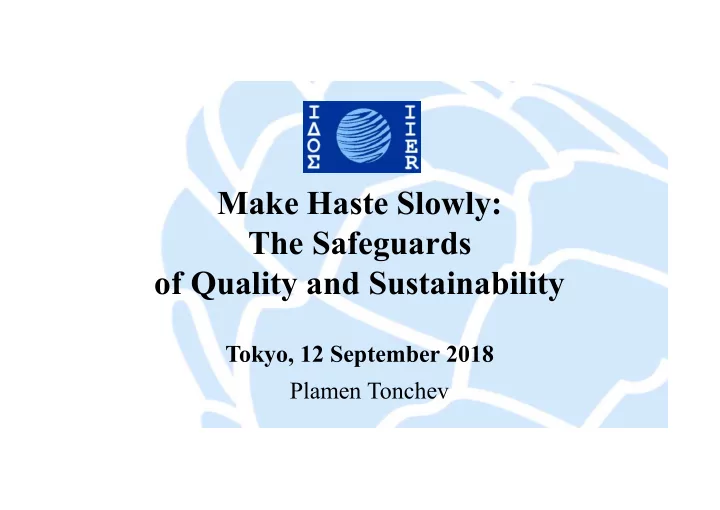

Make Haste Slowly: The Safeguards of Quality and Sustainability Tokyo, 12 September 2018 Plamen Tonchev
The Oxymoron ‘Make Haste Slowly’ 1. The ancient Greek phrase speûde bradéōs (σπεῦδε βραδέως) and its Latin translation Festina Lente . 2. Intent of the phrase: - Everything should be performed with a proper balance of urgency and diligence. - If tasks are overly rushed, mistakes are likely to be made, while long- term and high-quality results are unlikely to be achieved.
The Dilemma Speed vs Quality On the one hand, speed as a key feature of our rapidly changing world - keeping pace with new developments, new technologies, new concepts and new challenges. On the other hand, quality as an imperative for sustainability in a world that displays high levels of vulnerability and fragility.
Four Safeguards of Quality and Sustainability 1. Ensuring consensus among key stakeholders 2. Legal clarity as a sine qua non condition 3. Transparency - a level-playing field, avoiding suspicion 4. Sound financial planning, i.e. full life-cycle costing
ASEM Definition of Connectivity ASEM connectivity should be ‘ result-oriented, and in support of the following key principles: level playing field, free and open trade, market principles, multi-dimensionality, inclusiveness, fairness, openness, transparency, financial viability, cost-effectiveness and mutual benefits. It should also contribute to the materialisation of the principles, goals and targets of the 2030 Agenda for Sustainable Development. Sustainability is one of the important quality benchmarks for the connectivity initiatives in the ASEM context. ’
The Belgrade-Budapest railway as an example A prime example of ASEM connectivity: - Part of China’s Belt & Road Initiative (BRI); - Part of the Land Express Line from the Mediterranean to central Europe; - Four European countries involved directly or indirectly - Greece, the former Yugoslav republic of Macedonia, Serbia and Hungary.
Key Features of the Belgrade-Budapest railway - A 350 km railway track from Belgrade to Budapest; - Reported cost of $2.9 billion; - Maximum speed up to 160 km per hour; - Travel time to be reduced from 8 to 3.5 hours.
Question Marks Over the Hungarian Section - Total cost in the long run; - Benefits to be drawn by Hungary; - Deviation from EU rules on public procurement; - Lack of transparency.
Useful Lessons Learned 1. Initial project not based on a comprehensive and genuinely ‘win-win’ development strategy. 2. Project completion at least six years later than the initial deadline and ten years after relevant deliberations began. 3. Objections and suspicion could undermine long-term sustainability. 4. Question marks over the issue of debt servicing and the overall cost of the project.
EU Approach to Quality Infrastructure 1. Standards as ‘Business Angels’ and Indicators as ‘Quality Guardians’ - the gist of the EU contribution to the evolving ASEM debate on connectivity. 2. The cohort of ‘Business Angels’ - clear-cut standards in terms of transparency, environmental protection, labour safety, social cohesion, etc. 3. The legion of ‘quality guardians’, i.e. specific indicators.
THANK YOU!
Recommend
More recommend